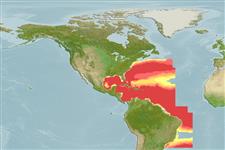Environment: milieu / climate zone / depth range / distribution range
Ecologia
marino; oceanodromo (Ref. 51243); distribuzione batimetrica 50 - ? m. Tropical; 20°C - ? (Ref. 168); 43°N - 28°S, 100°W - 26°W (Ref. 55290)
Western Atlantic: off Martha's Vineyard, Massachusetts south to Trinidad Island and Rio de Janeiro, Brazil (Ref. 168); including south of Brazil (Ref. 36453). Highly migratory.
Length at first maturity / Size / Peso / Age
Maturity: Lm 49.4 range ? - ? cm
Max length : 108 cm FL maschio/sesso non determinato; (Ref. 40637); common length : 72.0 cm FL maschio/sesso non determinato; (Ref. 168); peso massimo pubblicato: 20.6 kg (Ref. 40637)
Spine dorsali (totale): 13; Raggi dorsali molli (totale): 14-15; Spine anali 0; Raggi anali molli: 13 - 14; Vertebre: 39
Found in oceanic waters, sometimes not far from the coast (Ref. 13628). Forms large mixed schools with the skipjack tuna. Its spawning grounds are located well offshore. Preys on surface and deep-sea fishes, squids, amphipods, shrimps, crabs and stomatopods and decapod larvae. The largest fishery for blackfin tuna operates off the southeastern coast of Cuba and uses live-bait and pole. Utilized fresh, dried or salted, canned and frozen (Ref. 9987).
Life cycle and mating behavior
Maturità | Riproduzione | Deposizione | Uova | Fecundity | Larve
Collette, B.B. and C.E. Nauen, 1983. FAO Species Catalogue. Vol. 2. Scombrids of the world. An annotated and illustrated catalogue of tunas, mackerels, bonitos and related species known to date. Rome: FAO. FAO Fish. Synop. 125(2):137 p. (Ref. 168)
IUCN Red List Status (Ref. 130435)
Threat to humans
Harmless
Human uses
Pesca: commerciale; Pesce da pesca sportiva: si
Strumenti
Special reports
Download XML
Fonti Internet
Estimates based on models
Preferred temperature (Ref.
123201): 10 - 20.5, mean 14.4 °C (based on 163 cells).
Phylogenetic diversity index (Ref.
82804): PD
50 = 0.5039 [Uniqueness, from 0.5 = low to 2.0 = high].
Bayesian length-weight: a=0.01148 (0.00699 - 0.01886), b=3.05 (2.91 - 3.19), in cm total length, based on LWR estimates for this species & Genus-body shape (Ref.
93245).
Trophic level (Ref.
69278): 4.4 ±0.3 se; based on diet studies.
Resilienza (Ref.
120179): Medio, tempo minimo di raddoppiamento della popolazione 1.4 - 4.4 anni (K=0.22; tm=3; tmax=5).
Prior r = 0.77, 95% CL = 0.51 - 1.16, Based on 1 stock assessment.
Fishing Vulnerability (Ref.
59153): High vulnerability (61 of 100).
Climate Vulnerability (Ref.
125649): High to very high vulnerability (75 of 100).
Nutrients (Ref.
124155): Calcium = 48.4 [26.7, 111.0] mg/100g; Iron = 2.86 [1.11, 6.97] mg/100g; Protein = 22.9 [21.4, 24.3] %; Omega3 = 0.31 [0.19, 0.52] g/100g; Selenium = 84.5 [27.1, 268.2] μg/100g; VitaminA = 69.2 [9.8, 534.2] μg/100g; Zinc = 0.59 [0.31, 1.14] mg/100g (wet weight);
